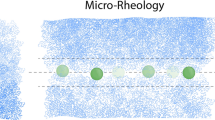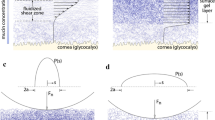Abstract
Many biological interfaces provide low friction aqueous lubrication through the generation and maintenance of a high water content polymeric surface gel. The lubricity of such gels is often attributed to their high water content, high water permeability, low elastic modulus, and their ability to promote a water film at the sliding interface. Such biological systems are frequently characterized as “soft,” where the elastic moduli are on the order of megapascals or even kilopascals. In an effort to explore the efficacy of such systems to provide lubricity, a thin and soft hydrogel surface layer (~5 μm in thickness) with a water content of over >80 % was constructed on a silicone hydrogel contact lens, which has a water content of approximately 33 %. Nanoindentation measurements with colloidal probes on atomic force microscopy (AFM) cantilevers revealed an exceedingly soft elastic modulus of ~25 kPa. Microtribological experiments at low contact pressures (6–30 kPa) and at slow sliding speeds (5–200 μm/s) gave average friction coefficients below μ = 0.02. However, at higher contact pressures, the gel collapsed and friction loops showed a pronounced stick–slip behavior with breakloose or static friction coefficient above μ = 0.5. Thus, the ability of the soft surface hydrogel layers to provide lubricity is dependent on their ability to support the applied pressure without dehydrating. These transitions were found to be reversible and experiments with different radii probes revealed that the transition pressures to be on the order of 10–20 kPa.





Similar content being viewed by others
References
Davidson, H.J., Kuonen, V.J.: The tear film and ocular mucins. Vet. Ophthalmol. 7(2), 71–77 (2004)
Coles, J.M., Chang, D.P., Zauscher, S.: Molecular mechanisms of aqueous boundary lubrication by mucinous glycoproteins. Curr. Opin. Colloid Interface Sci. 15(6), 406–416 (2010). doi:10.1016/j.cocis.2010.07.002
Yakubov, G.E., Mccoll, J., Bongaerts, J.H.H., Ramsden, J.J.: Viscous boundary lubrication of hydrophobic surfaces by mucin. Langmuir 25(4), 2313–2321 (2009). doi:10.1021/La8018666
Wang, J.J., Li, X.S.: Preparation and characterization of interpenetrating polymer network silicone hydrogels with high oxygen permeability. J. Appl. Polym. Sci. 116(5), 2749–2757 (2010). doi:10.1002/App.31902
Qiu, Y., Pruitt, J.D., Thekveli, S.J., Tucker, R.C., Nelson, J.: Sillicone hydrogel lenses with water-rich surfaces. USA Patent 20120026458
Qiu, Y., Samuel, N.T., Pruitt, J.D., Kolluru, C., Medina, A.N., Winterton, L.C., Wu, D., Qian, X., Nelson, J.: Silicone hydrogels with a crosslinked hydrophilic coating. USA. Patent 20120026457
Shaw, A.J., Collins, M.J., Davis, B.A., Carney, L.G.: Eyelid pressure and contact with the ocular surface. Invest. Ophthalmol. Vis. Sci. 51(4), 1911–1917 (2010). doi:10.1167/Iovs.09-4090
Roba, M., Duncan, E.G., Hill, G.A., Spencer, N.D., Tosatti, S.G.P.: Friction measurements on contact lenses in their operating environment. Tribol. Lett. 44(3), 387–397 (2011). doi:10.1007/s11249-011-9856-9
Zhou, B., Li, Y.T., Randall, N.X., Li, L.: A study of the frictional properties of senofilcon—a contact lenses. J. Mech. Behav. Biomed. 4(7), 1336–1342 (2011). doi:10.1016/j.jmbbm.2011.05.002
Nairn, J.A.: Measurement of the friction and lubricity properties of contact lenses. In: ANTEC: The Plastics Challenger: A Revolution in Education 1995, p. 3384. Society of Plastics Engineers
Rennie, A.C., Dickrell, P.L., Sawyer, W.G.: Friction coefficient of soft contact lenses: measurements and modeling. Tribol. Lett. 18(4), 499–504 (2005). doi:10.1007/s11249-005-3610-0
Ngai, V., Medley, J.B., Jones, L., Forrest, J., Teichroeb, J.: Friction of contact lenses: Silicone hydrogel versus conventional hydrogel. In: 31st Leeds-Lyon Symposium on Tribology, Trinity and All Saints College, Horsforth, Leeds, 2004. Tribology and Interface Engineering Series, pp. 371–379 (2005)
Tighe, B.: Measurement of frictional characteristics of contact lenses. In: BCLA Annual Clinical Conference, Birmingham, 2006, pp. 201–202. Contact Lens & Anterior Eye (2006)
Tucker, R.C., Quinter, B., Patel, D., Pruitt, J.D., Nelson, J.: Qualitative and Quantitative Lubricity of Experimental Contact Lenses. Paper presented at the ARVO, Fort Lauderdale, FL, 10 May 2012
Bonnevie, E.D., Baro, V.J., Wang, L., Burris, D.L.: Fluid load support during localized indentation of cartilage with a spherical probe. J. Biomech. 45(6), 1036–1041 (2012). doi:10.1016/j.jbiomech.2011.12.019
Schmitz, T.L., Action, J.E., Ziegert, J.C., Sawyer, W.G.: The difficulty of measuring low friction: uncertainty analysis for friction coefficient measurements. J Tribol-T Asme 127(3), 673–678 (2005). doi:10.1115/1.1843853
Perry, S.S., Yan, X.P., Limpoco, F.T., Lee, S., Muller, M., Spencer, N.D.: Tribological properties of poly(l-lysine)-graft-poly(ethylene glycol) films: influence of polymer architecture and adsorbed conformation. Acs Appl Mater Inter 1(6), 1224–1230 (2009). doi:10.1021/Am900101m
Dunlop, I.E., Thomas, R.K., Titmus, S., Osborne, V., Edmondson, S., Huck, W.T.S., Klein, J.: Structure and collapse of a surface-grown strong polyelectrolyte brush on sapphire. Langmuir 28(6), 3187–3193 (2012). doi:10.1021/La204655h
Thekveli, S.J.: Structure–property relationship of delefilcon A lenses. Paper presented at the BCLA Conference 2012, Birmingham, UK
Hutter, J.L., Bechhoefer, J.: Calibration of atomic-force microscope tips. Rev. Sci. Instrum. 64(7), 1868–1873 (1993)
Uruena, J.M., Dunn, A.C., Sawyer, W.G.: Contact lens boundary lubrication and friction reduction with hyaluronic acid. Tribol. Lubr. Technol. 67(12), 14–15 (2011)
Johnson, K.L.: Contact Mechanics. Cambridge University Press, Cambridge (1987)
Kuznetsova, T.G., Starodubtseva, M.N., Yegorenkov, N.I., Chizhik, S.A., Zhdanov, R.I.: Atomic force microscopy probing of cell elasticity. Micron 38(8), 824–833 (2007). doi:10.1016/j.micron.2007.06.011
Straehla, J.P., Limpoco, F.T., Dolgova, N.V., Keselowsky, B.G., Sawyer, W.G., Perry, S.S.: Nanomechanical probes of single corneal epithelial cells: shear stress and elastic modulus. Tribol. Lett. 38(2), 107–113 (2010). doi:10.1007/s11249-010-9579-3
Abu-Lail, N.I., Kaholek, M., LaMattina, B., Clark, R.L., Zauscher, S.: Micro-cantilevers with end-grafted stimulus-responsive polymer brushes for actuation and sensing. Sensor Actuat. B 114(1), 371–378 (2006). doi:10.1016/j.snb.2005.06.003
Kim, P., Zarzar, L.D., Zhao, X.H., Sidorenko, A., Aizenberg, J.: Microbristle in gels: toward all-polymer reconfigurable hybrid surfaces. Soft Matter 6(4), 750–755 (2010). doi:10.1039/B920392c
Huck, W.T.S.: Responsive polymers for nanoscale actuation. Mater. Today 11(7–8), 24–32 (2008)
Muller, M.T., Yan, X.P., Lee, S.W., Perry, S.S., Spencer, N.D.: Lubrication properties of a brushlike copolymer as a function of the amount of solvent absorbed within the brush. Macromolecules 38(13), 5706–5713 (2005). doi:10.1021/Ma0501545
Vyas, M.K., Schneider, K., Nandan, B., Stamm, M.: Switching of friction by binary polymer brushes. Soft Matter 4(5), 1024–1032 (2008). doi:10.1039/B801110a
Makkar, C., Hu, G., Sawyer, W.G., Dixon, W.E.: Lyapunov-based tracking control in the presence of uncertain nonlinear parameterizable friction. IEEE Trans. Automat. Contr. 52(10), 1988–1994 (2007). doi:10.1109/Tac.2007.904254
Acknowledgments
The authors gratefully acknowledge Drs. Pruitt and Sentell of Alcon Laboratories for many useful discussions on contact lenses and hydrogels, and for providing the delefilcon A lenses. This work was funded by Alcon Laboratories.
Author information
Authors and Affiliations
Corresponding author
Rights and permissions
About this article
Cite this article
Dunn, A.C., Urueña, J.M., Huo, Y. et al. Lubricity of Surface Hydrogel Layers. Tribol Lett 49, 371–378 (2013). https://doi.org/10.1007/s11249-012-0076-8
Received:
Accepted:
Published:
Issue Date:
DOI: https://doi.org/10.1007/s11249-012-0076-8




